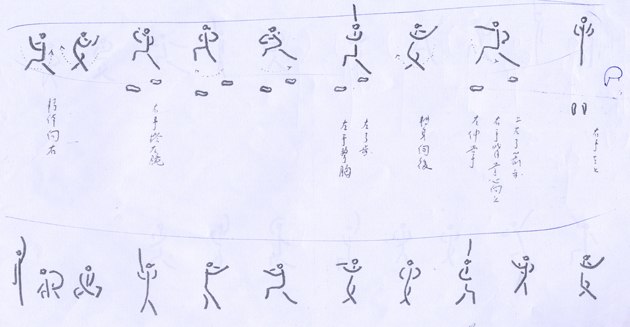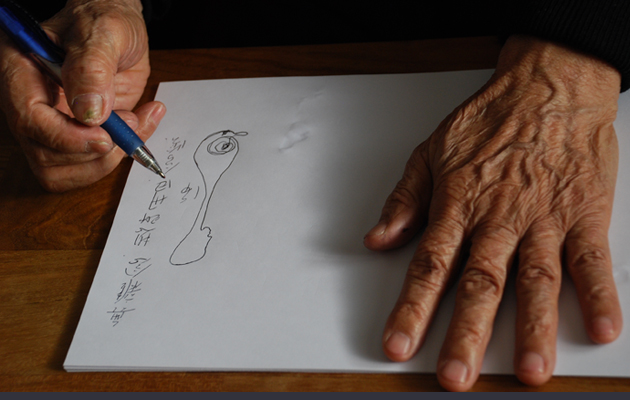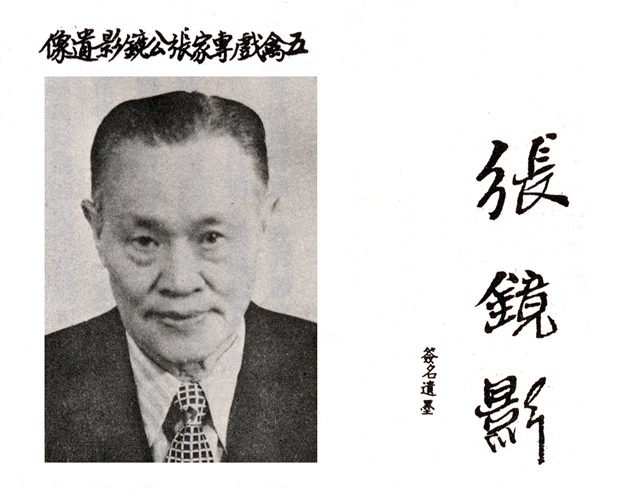
In the Authentic Five Animals Qigong (★1), the word < Authentic > implies two meanings.
First is the point of retaining the form intact as handed down through the ages. Among the Five Animals Qigong, the most perfect traditional (125 forms) Authentic Five Animal Qigong from Taiwan was first introduced in Korea by the Daoyin Research Group. Prior to the advent of the Authentic Five Animals Qigong, most of the Five Animals Qigong introduced domestically had been abbreviated in form. 
Personal handwriting of one of the original disciples of the Authentic Five
Animals Qigong.
Second is the significance of the core of Daoyin being wholly preserved,
the secret techniques of managing human Qi. the Coordinated Effect of Three Body Parts to actualize
Qi can be considered the essence of Daoyin.
The presence of the coordinated effect of three body parts in the movements is the key criteria
to indicate whether Daoyin bears resemblance to the traditional form. In the Authentic Five Animals
Qigong, since there are prescribed for each movement proper Qi management for the Coordinated Effect
of Three Body Parts, the efficacy of each individual motion, and response by each part of the body
is precise. The significance of each movement is explained in minute detail. Once the coordinated
triad effect is understood, even simple gestures can have profound effect.

Explanation of the Authentic Five Animals Qigong on internal energy
management secrets.
In the Daoyin Research Group, though there are situations, as dictated by
the practicalities of modern society to teach select movements from the Authentic Five Animals Qigong,
or to simplify complex movements for learning, but the Coordinated Effect of Three Body Parts is
strictly observed without exception.
Thereby, what is considered as the root of Huatuo's Five Animals Qigong, the Authentic style and
that method more appropriate to the modern situation, both are encompassed respectively, for
their fundamental philosophy and practicality.

Today there are many types of Five Animals Qigong being handed down, but the
most systematic and also robust in the original intent and the old tradition of Huatuo is the Five
Animals Qigong handed down by Master Zhang Jingying of Taiwan.
During Zhang’s participation in the war against Japan, a fellow commanding officer from the same unit was seriously injured in the legs by an attack from a Japanese aircraft to require a doctors diagnosis for amputation of the leg. In the desperate search for some way to save the leg, they invited a Taoist master from Qingcheng Mountain in Sichuan Province, who for 49 days was holed up for a so called “secret treatment ”to witness an unbelievable miracle cure. Intrigued by what he saw, Zhang begged the master to teach him the traditional Five Animals Qigong which he diligently practiced. This was the happenstance by which the Authentic Five Animals Qigong came to make inroads to Taiwan. 
Master Zhang Jing-ying (1899~1980)
Master Zhang crossed over to Taiwan in 1949, to teach the Authentic Five Animals Qigong for the
first time in 1956, but only a very few could master all of it. So 1956, in Taiwan Legislature
lecture hall, when the authentic form of Five Animals Qigong was taught for the first time, more than
80 people got started, but only two remained until the end, who later in the 60’s continued to
receive training from Master Zhang and fellowshipped.
From these two disciples only one person to carry the unending tradition of
authenticity, and in Korea also it was this same Authentic Five Animals Qigong which was passed
along through the Daoyin Research Group.

Master Zhang continued to teach the Five Animals Qigong until he passed away in 1980, but the number
of people who have weaned training were not many. Moreover as time passes, some are being distorted
into other forms for discipleship. For people taught in one location to each study differently is a
common scene, in Five Animals Qigong and all other traditional training forms. Also,
Master Zhang is reported to have taught differently according to the age,
physical ability, the depth of study, etc. for the people teaching.
Consequently mong the Five Animals Qigong supplied thereafter, changes to Master
Zhang’s original method will also be inevitable.
Simplified forms stripped down over one third of the 125 movements, to leave only one side of a
repetition left or right, to change the complex part of each move to something simple, Important
aspects of Tu-Na breathing(★2) and the workings of internal energy were glossed over for an
abbreviated forms to emerge.
This served to have some positive influence on the supply of Five Animals Qigong.
(★1) Once there was only the terminology Huatuo's Five Animals Qigong, but the Five Animals Qigong
which the Daoyin Research Group has upheld and is now introducing, is wider in scope when compared
with the existing Five Animals Qigong, fully possessive of the depth of meaning from the old times,
and now called by the name Authentic Five Animals Qigong.
(★2) Tu-Na breathing refers to the breathing technique for each movement. Not the artificial respiration through the respiratory system, but the movement to stretch out then withdraw the limbs, extending then bending the torso, for breathing to be generated naturally from body internal pressure. One Tu-Na breathing is properly achieved, various parts of the body will be influenced by the pressure and stimuli of breathing from the motions, and enabled to control the internal organ parts. |






